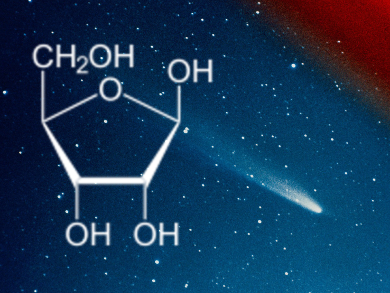The genetic material of living organisms is made up of nucleic acids, either DNA or RNA. RNA is thought to have been one of the first molecules characteristic of life to appear on Earth. Some researchers believe that life on Earth was “seeded” by comets or asteroids that contained the basic building blocks of proteins or nucleic acids. Several amino acids and nucleobases have already been found in meteorites, as well as in artificial comets produced in the laboratory [1,2].
Cornelia Meinert, Uwe Meierhenrich, and colleagues, Université de Nice Sophia Antipolis, France, have successfully detected ribose, a key component of RNA, in a simulation of the interstellar ice which makes up comets. The team produced an artificial comet containing a mixture of water, methanol, and ammonia in a vacuum chamber at –200 °C. This material was irradiated with ultraviolet (UV) radiation to simulate the conditions in the molecular clouds where comets form. The sample was then warmed to room temperature, as in comets when they approach the sun.
The composition was analyzed using multidimensional gas chromatography (GC) coupled with time-of-flight mass spectrometry (TOF-MS). The researchers detected several sugars, including ribose, arabinose, lyxose, and xylose. Their diversity and relative abundances suggest that they were formed from formaldehyde.
These results expand the list of the molecular building blocks of life that can be formed in interstellar ice. However, the existence of ribose in real comets remains to be confirmed.
- Ribose and related sugars from ultraviolet irradiation of interstellar ice analogs,
Cornelia Meinert, Iuliia Myrgorodska, Pierre de Marcellus Thomas Buhse, Laurent Nahon, Soeren V. Hoffmann, Louis Le Sergeant d’Hendecourt, Uwe J. Meierhenrich.
Science 2016.
DOI : 10.1126/science.aad8137
References
- [1] Amino Acids from Ultraviolet Irradiation of Interstellar Ice Analogues,
G. M. Muñoz Caro, U. J. Meierhenrich, W. A. Schutte, B. Barbier, A. Arcones Segovia, H. Rosenbauer, W. H.-P. Thiemann, A. Brack, J. M. Greenberg,
Nature 2002, 416, 403–406.
DOI: 10.1038/416403a - [2] How Amino Acids Formed in the Universe,
Vera Koester, Uwe Meierhenrich,
ChemViews Mag. 2015.
DOI: 10.1002/chemv.201500104
Professor Meierhenrich, France, about his involvement in the Rosetta mission and its importance for chemists



